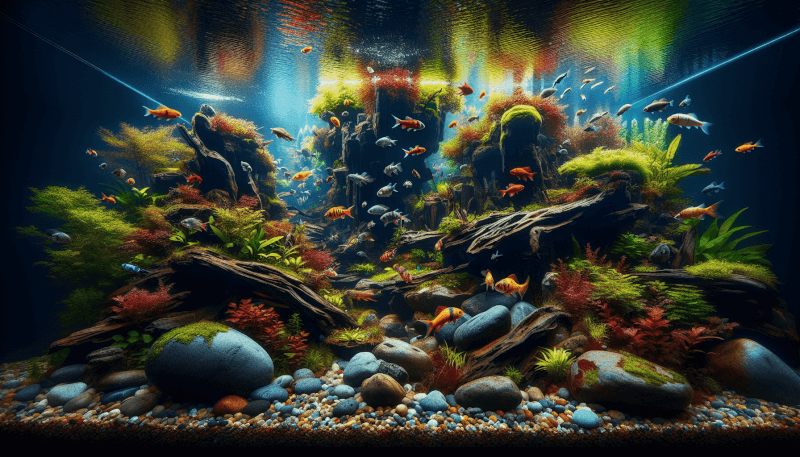Immerse yourself in the soothing beauty of the underwater world with the art of creating a meditative and tranquil aquarium aesthetic. Discover the secrets to transforming your aquarium into a serene oasis that will transport you to a state of calm and tranquility. From carefully selecting fish species known for their peaceful nature, to designing a harmonious aquascape, this article will guide you in creating an aquarium that not only enhances the aesthetic appeal of your space but also promotes a sense of tranquility and relaxation. Get ready to dive into the mesmerizing world of underwater serenity like never before.

Choosing the Right Aquarium
Consider the Size and Shape
When choosing an aquarium, it is important to consider both the size and shape that will best fit your space and personal preferences. Think about the available space in your home or office and determine whether you want a compact tank or a larger centerpiece aquarium. Additionally, consider the shape of the aquarium. Rectangular tanks are the most common and provide a traditional look, while bow-front or cylindrical tanks can add a unique visual appeal.
Select the Appropriate Material
Aquariums are typically made of glass or acrylic, and each material has its pros and cons. Glass is more scratch-resistant and does not discolor over time, providing clear visibility into the tank. Acrylic, on the other hand, is lighter and more durable, making it less likely to crack or shatter. Consider your priorities and choose the material that suits your needs best.
Decide on the Type of Aquarium
There are different types of aquariums to choose from, including freshwater, saltwater, and planted aquariums. Freshwater aquariums are the most common choice for beginners, as they are easier to maintain and require less specialized equipment. Saltwater aquariums, although more challenging to maintain, offer a wide range of colorful and diverse fish and coral species. Planted aquariums focus on creating a natural and lush underwater garden, with live aquatic plants playing a central role.
Creating a Natural Environment
Selecting the Right Substrate
The substrate in your aquarium not only serves as a decorative element but also plays a crucial role in providing a suitable environment for your fish and plants. Choose a substrate that is appropriate for the type of aquarium you have, whether it’s gravel, sand, or specialized substrates designed for planted tanks. Consider the color and texture of the substrate to create the desired aesthetic and ensure that it provides a comfortable home for your aquatic life.
Choosing Suitable Plants
Plants are essential for creating a natural environment in your aquarium. They provide oxygen, help maintain water quality, and serve as hiding places for fish. Research the specific needs of different plant species and choose ones that are suitable for your aquarium setup. Consider factors such as lighting requirements, carbon dioxide supplementation, and growth rate to ensure the health and vitality of your aquarium plants.
Adding Driftwood and Rocks
Driftwood and rocks not only add visual interest to your aquarium but also provide hiding spots and natural territories for your fish. These elements can create caves or crevices for shy species and add a sense of depth and complexity to your underwater landscape. Make sure to choose driftwood and rocks that are aquatic-safe and have been properly cleaned to prevent any unwanted chemicals or bacteria from entering the aquarium.
Creating the Perfect Water Conditions
Maintaining Ideal Temperature
Maintaining a stable and ideal water temperature is crucial for the health and well-being of your fish. Different fish species have different temperature requirements, so it’s important to research the needs of your specific fish. Use a reliable aquarium heater to regulate the water temperature and invest in a good-quality thermometer to monitor it regularly. Keep in mind that abrupt temperature fluctuations can stress or even harm your fish, so aim for stability in your aquarium’s temperature.
Ensuring Optimal Water Quality
Proper water quality is vital for the health of your aquarium’s inhabitants. Regularly test the water for parameters such as pH, ammonia, nitrite, and nitrate levels using a water testing kit. Consider investing in a high-quality water conditioner to remove harmful chemicals and toxins from tap water before adding it to your aquarium. Additionally, establishing a regular water change schedule and maintaining a balanced nitrogen cycle will help ensure optimal water quality.
Using a Proper Filtration System
A reliable filtration system is essential for maintaining a clean and healthy aquarium. There are several types of filtration systems, including mechanical, chemical, and biological filters. Mechanical filters remove debris and particles, chemical filters remove dissolved impurities, and biological filters support the growth of beneficial bacteria that break down harmful substances in the water. Choose a filtration system that is appropriate for the size and needs of your aquarium, and make sure to regularly clean or replace the filter media to maintain its effectiveness.
Strategic Placement of Decorations
Creating Visual Depth with Backgrounds
Using a background in your aquarium can create a sense of depth and enhance the overall aesthetic. Choose a background that complements the theme or natural environment you are trying to create. Options range from simple solid colors to intricate underwater scenes. Consider utilizing 3D backgrounds to add realism and depth, creating a visually appealing backdrop for your aquarium inhabitants.
Utilizing Strategic Lighting Options
Proper lighting is crucial for the health and growth of your aquarium plants and enhances the overall visual appeal of your aquarium. Research the lighting requirements of your specific plant species and choose a lighting system that provides the appropriate intensity and spectrum of light. Consider using LED lights, as they are energy-efficient, customizable, and provide a natural-looking illumination for your aquatic environment.
Adding Ornamental Features
In addition to plants and natural elements, incorporating ornamental features can add a touch of personality to your aquarium. Decorative elements such as statues, castles, or submerged figurines can create focal points or thematic accents. However, be mindful not to overcrowd the tank with too many decorations, as this can restrict swimming space for your fish and impede water flow. Aim for a balanced and harmonious arrangement that enhances the overall aesthetic without compromising the well-being of your aquatic life.

Choosing Compatible Fish Species
Researching Fish Compatibility
When selecting fish for your aquarium, it is essential to research their compatibility with each other. Some fish species are more aggressive and territorial, while others are peaceful and thrive in community setups. Take into account factors such as size, temperament, and dietary needs to ensure the harmonious coexistence of your fish. Avoid mixing incompatible species that may harm or stress each other, and seek expert advice or consult reputable sources for guidance in creating a compatible fish community.
Considering the Right Number of Fish
Determining the right number of fish for your aquarium depends on factors such as tank size, filtration capacity, and individual fish requirements. Overstocking can lead to poor water quality, stress, and disease outbreaks, while understocking may result in loneliness or boredom for your fish. Research the adult size and preferred shoaling requirements of your chosen fish species and aim for a balanced and suitable number of individuals that can thrive in your aquarium.
Taking Care of Different Species’ Requirements
Each fish species has specific care requirements in terms of water parameters, feeding habits, and social dynamics. Stay informed about the specific needs of the fish species you keep and ensure that you are providing them with an environment that meets their requirements. Consider factors such as water temperature, pH level, and dietary preferences when setting up your aquarium and make adjustments as needed to maintain the health and well-being of your fish.
Proper Aquarium Maintenance
Regular Water Changes
Performing regular water changes is essential for maintaining a healthy aquarium. Regular water changes help remove accumulated toxins, replenish essential minerals, and ensure optimal water quality. Depending on your aquarium’s needs, aim for weekly or bi-weekly water changes, replacing approximately 10-20% of the water volume. Use a siphon or a gravel vacuum to remove debris from the substrate during water changes, preventing the buildup of harmful contaminants.
Maintaining a Balanced Ecosystem
A balanced ecosystem is crucial for the overall well-being and longevity of your aquarium. This involves monitoring and maintaining the nitrogen cycle, which is the process by which toxic ammonia is converted into less harmful nitrate. Regularly test the water parameters and make adjustments as needed to ensure stable conditions for your aquatic life. Avoid overfeeding your fish, as excessive food can lead to poor water quality and various health issues.
Cleaning and Pruning
Regular cleaning and pruning of your aquarium are necessary to prevent the buildup of organic matter and to maintain the aesthetic appeal of your aquascape. Use a soft-bristle brush or an algae scraper to remove algae from the tank walls, being cautious not to scratch the glass or acrylic. Trim and remove any dead or decaying plant matter to promote the growth of healthy plants and prevent the release of harmful substances into the water. Regular maintenance activities contribute to a clean and thriving aquarium environment.

Enhancing the Aesthetic with Aquascaping
Incorporating the Principles of Design
Aquascaping is the art of arranging aquatic elements in your aquarium to create a visually appealing and harmonious composition. Consider the principles of design, such as balance, proportion, contrast, and focal points, when arranging plants, decorations, and other elements. Create a sense of depth and perspective by placing taller plants or ornaments in the background and shorter ones in the foreground. Experiment with different layouts and arrangements to achieve a visually stunning aquascape.
Using Proportions and Focal Points
Proportions and focal points are crucial aspects of aquascaping that can greatly enhance the overall visual impact of your aquarium. Use the golden ratio or rule of thirds to determine the optimal placement and proportions of plants and decorations in your aquascape. Create focal points by strategically placing standout elements such as colorful plants, driftwood, or unique ornaments. These focal points draw the viewer’s attention and add depth and interest to your aquarium.
Creating Harmony and Balance
Creating a harmonious and balanced aquascape involves careful consideration of the overall composition. Aim for a cohesive and natural arrangement that mimics the beauty of a natural ecosystem. Consider the colors, shapes, and textures of your aquatic plants and decorations, ensuring that they complement each other and create a unified visual experience. Avoid overcrowding or cluttering the tank, as this can disrupt the sense of balance and serenity you are trying to achieve.
Promoting Tranquility with Sound and Movement
Adding a Relaxing Water Flow
The sound and movement of water can greatly contribute to the tranquility and meditative qualities of your aquarium. Consider adding a water pump or a powerhead to create gentle water movements that mimic natural river currents. This not only adds a soothing element to your aquarium but also helps simulate the natural habitat of your fish. Experiment with different flow rates and directions to find the perfect balance that promotes relaxation and a sense of serenity.
Incorporating Gentle Bubble Effects
Bubble effects can add an additional layer of relaxation and visual interest to your aquarium. Air stones or bubble walls create a mesmerizing display of rising bubbles, which can have a calming effect on both you and your fish. Experiment with different bubble sizes and patterns to find the one that suits the overall aesthetic and mood of your aquarium. Remember to regulate the air flow to prevent excessive turbulence or disruption to your fish.
Selecting Silent Equipment
The noise emitted by aquarium equipment, such as filters or air pumps, can greatly affect the tranquility of your aquascape. Opt for high-quality and silent equipment to minimize unwanted noise. Look for products specifically designed for quiet operation or consider using sound-dampening materials to reduce vibrations and noise. Ensuring a serene auditory experience enhances the meditative qualities of your aquarium, allowing you to fully immerse yourself in its calming ambiance.

Controlling Algae and Other Common Issues
Preventing and Treating Algae Growth
Algae growth is a common issue in aquariums and can detract from the overall aesthetic. To prevent excessive algae growth, maintain consistent lighting duration and intensity, avoid overfeeding, and perform regular water changes. If algae problems arise, several methods can help control and remove algae, such as reducing lighting duration, manually removing algae using an algae scraper or brush, or introducing algae-eating fish or invertebrates. Proper maintenance and proactive measures are key to keeping algae growth in check.
Managing Fish Diseases and Parasites
Fish diseases and parasites can pose a significant threat to the well-being of your aquarium inhabitants. Regular observation and monitoring of your fish’s behavior and appearance can help detect early signs of illness. Quarantine new fish before introducing them to your main tank to prevent the spread of diseases. If health issues arise, consult with a veterinarian experienced in aquatic medicine for proper diagnosis and treatment options. Maintaining optimal water quality and a stress-free environment also play crucial roles in preventing diseases.
Troubleshooting Common Problems
Aquariums may encounter various common problems, including cloudy water, equipment failures, or fish compatibility issues. Cloudy water can be caused by factors such as overfeeding, insufficient filtration, or a bacterial bloom. Address these issues by adjusting feeding habits, improving filtration, or performing appropriate water changes. In the event of equipment failures, promptly address the issue to prevent further damage. When faced with fish compatibility issues or aggression, consider rehoming or separating the aggressive fish to maintain harmony within the tank.
Meditative Practices with the Aquarium
Observing and Reflecting on the Fish
One of the greatest joys of having an aquarium is the opportunity to observe and reflect on the behaviors and interactions of your fish. Spend time watching your fish as they swim, explore their environment, and interact with each other. Observe their unique characteristics, appreciate their beauty, and reflect on the serene and calming qualities they bring to your space. This mindful observation can serve as a form of meditation, allowing you to deeply connect with nature and find tranquility in the aquatic world.
Utilizing Aquarium as a Focus Point for Meditation
An aquarium can serve as a focal point for meditation, providing a visual anchor to focus your attention and quiet your mind. Find a comfortable position near your aquarium, take deep breaths, and allow your gaze to rest on the soothing movements and colors within the tank. As you observe the tranquil underwater world, let go of any racing thoughts and immerse yourself in the present moment. Use this time to cultivate mindfulness, reduce stress, and find inner peace.
Creating a Calming Routine
Incorporating your aquarium into a daily or weekly routine can enhance its meditative qualities and contribute to a sense of tranquility in your life. Make time each day to observe and care for your aquarium, checking on the well-being of your fish and maintaining its overall health and aesthetics. Establishing this calming routine allows you to reconnect with nature and create a serene atmosphere in your home or office. Embrace the opportunity to find peace and relaxation through the art of aquarium keeping.
In conclusion, creating a meditative and tranquil aquarium aesthetic requires careful consideration of various factors, including the selection of the right aquarium, the creation of a natural environment, the establishment of perfect water conditions, strategic placement of decorations, choosing compatible fish species, proper aquarium maintenance, enhancing the aesthetic with aquascaping, promoting tranquility with sound and movement, controlling algae and common issues, and lastly, using the aquarium as a source of meditation. By following these guidelines and investing time and effort into the art of aquarium keeping, you can create a captivating underwater world that promotes serenity, mindfulness, and a sense of tranquility.


